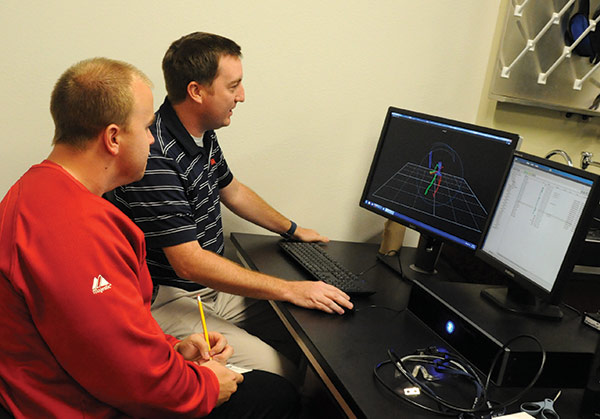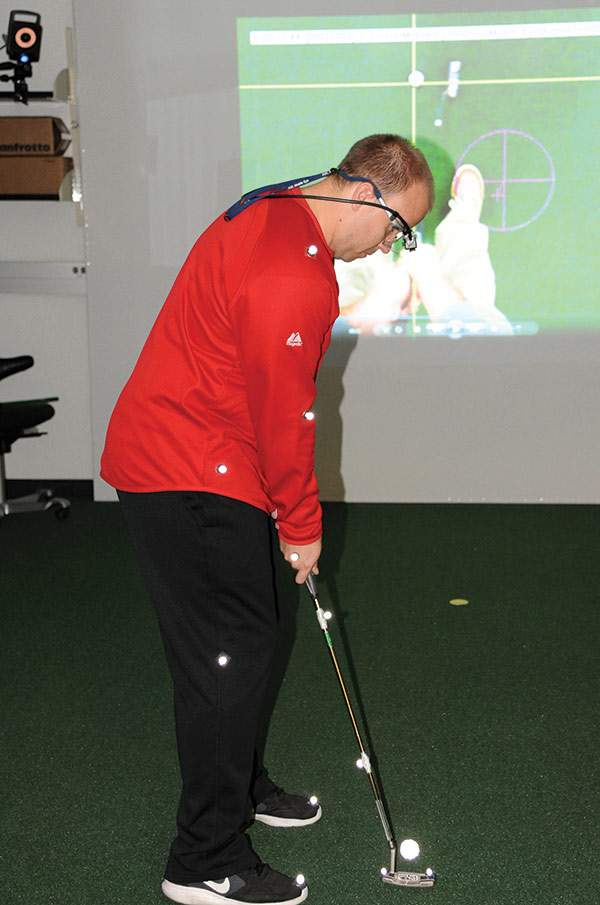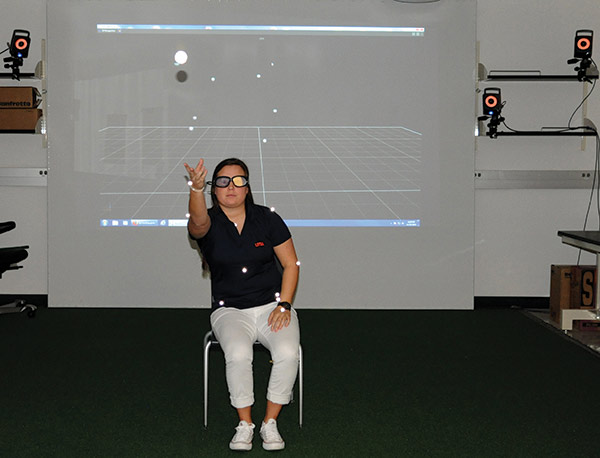

Action: The athlete swings his golf club. Effect: A golf ball rolls to one end of the room. In the seconds before and after the action and its effect, six specialized cameras capture the motions of the athlete, the club, and the ball.
Nearby, William Land, assistant professor of kinesiology at The University of Texas at San Antonio (UTSA) watches as real-time, three-dimensional representations of each appear on his computer monitors and on the large projection wall at the back of the laboratory.
This is the UTSA Human Performance Laboratory. In it, Land and his graduate student assistants are working on understanding the cognitive and psychological factors that influence human movement, athleticism and–as the name suggests—performance.

“Fundamentally, humans move to bring about desired effects and outcomes in the environment. Athletes in particular train very hard to ensure their movements produce consistent effects,” said Land, who is an expert in sports psychology, attention and focus, and athletes choking under pressure.
According to Land, professional athletes excel at developing cognitive techniques for producing consistent motion such as anticipating the desired effects and outcomes of a skill. After extensive practice, the movements to produce those effects, like scoring a basket or pitching a ball, become almost automatic and require significantly less mental effort to do correctly.

Currently, Land is engaged in two ongoing research studies with a group of UTSA graduate students who assist him in the laboratory. The first project deals with figuring out how the relationships between a subject’s actions and its consequences can be used to improve learning and performance. The second study aims to understand how “attentional focusing,” or what someone is thinking about, can translate into greater accuracy during movement and performance.
In order to better understand and visualize these concepts, the UTSA laboratory is home to a variety of specialized equipment designed to assist in Land’s research. The technology includes motion capture equipment and cameras, Doppler software and hardware that can track movement in the air, and visual occlusion glasses that can manipulate a subject’s vision at the researchers’ wills.
“Through our state-of-the-art equipment and set-up, we can manipulate everything from visual to aural feedback and see in real-time the changes in subjects’ performances,” said Land. “It really helps us get a sense of how human cognition drives the body in performing actions, and this knowledge is important for facilitating the training and learning of motor skills.”

Though Land and his assistants conduct their research using athletic performance as their main frame of reference, Land imagines their findings and research can be translated into other contexts, too.
“Every day, we’re finding new applications for our work,” said Land. “I can easily see our work being used to help in physical therapy and rehabilitation to improve patients’ motions, for example, and we are beginning to make exploratory efforts into seeing the applications available there.”

Nearly 10 years ago, Dr. Jorge Solís, assistant professor of bicultural and bilingual Studies, set out on a quest to help support and increase access to science in bilingual and linguistically diverse classrooms. His most recent four-year study, which brings together colleagues from Arizona State University, the University of Arizona, and the University of California, Santa Cruz, has tested the effectiveness of a teaching model designed for pre-service and novice teachers in these types of classrooms.
“When secondary science teachers think of English language learners, they think of just using vocabulary as a strategy,” said Solís, who directs the UTSA portion of the multi-site project. “We are helping them become aware that it there are many more strategies they can use, like modifying the way they speak and changing how they structure activities in the classroom.”
The project, “Secondary Science Teaching with English Language and Literacy Acquisition” (SSTELLA), is completing the final phase of the study by following up with teacher education graduates across the four sites in their first and second year of full-time teaching.
“The data collection focuses on our case study teachers who graduated two years ago,” said Solís. “Now, they are in their second year of teaching at sites across the city and we are seeing how the model is holding up in their everyday teaching of science.”
Preliminary results have shown that there is a parallel between how professors were modeling and reflecting the practices with the teachers and how the teachers ended up doing while completing their clinical teaching and their first two years of teaching.
“When we implemented the model we developed, we saw a positive impact,” said Solís. “It’s something we want to continue to work on because this is the kind of audience we want to target. We want teachers to see themselves as more capable of teaching scientific concepts to linguistically diverse students not just early on, but throughout their careers.”
Recently, the researchers published a book on the project, “Secondary Science Teaching for English Learners: Developing Supportive and Responsive Learning Contexts for Sense-Making and Language Development,” which is endorsed by the National Science Teachers Association, that shared some of these initial findings. So far, the project has been successful with first year teachers being able to adapt some of the curriculum from the model into different classroom contexts.
“The book is really trying to bring to life some of these concepts in real time with pretty particular kinds of classrooms contexts,” said Solís. “We are seeing how the teachers are still using the model we developed and how it has impacted their students, which is a significant part of the study.”
The project, which is funded by the National Science Foundation’s Discovery Research K-12 Program, has been a labor of love for Solís and the SSTELLA collaborators for the last four years.
“The teacher education field, especially in terms of science education, has just grown leaps and bounds over the last 15 years, and that just goes to show that there is an interest in addressing this from a pre-service teacher perspective,” said Solís. “Working on a project like this has pushed me to dig deeper into the field, a field that includes linguists, science educators, and cultural psychologists. It has been eye opening and challenging, but it shows that there are now greater avenues of access to science education for diverse populations.”